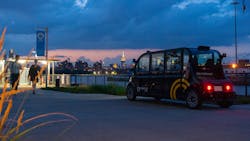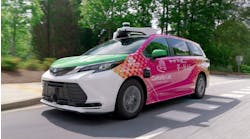Two projects further strengthen bonds between microtransit and autonomous vehicles
The launch of a program at Brooklyn Navy Yard and a new partnership between a robotics and engineering company in Indiana further exemplify the niche autonomous vehicles are carving out in microtransit applications.
Six autonomous vehicles started transporting commuters between Brooklyn’s NYC Ferry stop at Dock 72 and the Brooklyn Navy Yard Cumberland Gate on Aug. 7. Optimus Ride, the self-driving vehicle technology company behind the service, says its aim is to provide a safe, efficient means of mobility in areas where there is a lack of options
An estimated 500 passengers per day and more than 16,000 passengers per month will make the trip via the AVs to the Brooklyn Navy Yard industrial park, which is undergoing a $1 billion expansion and houses more than 400 manufacturing businesses and 10,000 onsite employees. Optimus Rides notes there will be a safety driver and software operator in the vehicle. The system will run on a continuous loop between 7:00 am and 10:30 pm on weekdays between the dock and the Cumberland Gate. On weekends the system will run between the dock and Building 77 during those same time periods.
Ryan Chin, CEO and co-founder of Optimus Ride, said the launch of the Brooklyn Navy Yard service is validation that “autonomous vehicles can solve real-world problems in structured environments.”
In other microtransit and AV news, PerceptIn and LHP Engineering Solutions (LHP) have partnered to deliver autonomous modular solutions that the companies say will transform a traditional human-operated vehicle into a self-driving machine.
PerceptIn's DragonFly Pod is a low-speed, road-ready vehicle that combines vision-based sensor fusion with a modular computing system. LHP will bring its functional safety and data analytics expertise to the partnership, which LHP CEO and Co-Founder David Glass explains “can introduce connected autonomous solutions to an industry without risking any disruptions to consumer safety.”
Shaoshan Liu, CEO and founder of PerceptIn, believes the partnership can revolutionize the microtransit industry and envisions delivery of services to public transit in urban settings, such as on university campuses, in city centers or at corporate campuses.

Mischa Wanek-Libman | Group Editorial Director
Mischa Wanek-Libman is director of communications with Transdev North America. She has more than 20 years of experience working in the transportation industry covering construction projects, engineering challenges, transit and rail operations and best practices.
Wanek-Libman has held top editorial positions at freight rail and public transportation business-to-business publications including as editor-in-chief and editorial director of Mass Transit from 2018-2024. She has been recognized for editorial excellence through her individual work, as well as for collaborative content.
She is an active member of the American Public Transportation Association's Marketing and Communications Committee and served 14 years as a Board Observer on the National Railroad Construction and Maintenance Association (NRC) Board of Directors.
She is a graduate of Drake University in Des Moines, Iowa, where she earned a Bachelor of Arts degree in Journalism and Mass Communication.

